History of Perplexus, aka Superplexus
- perplexus
- adjective · Latin
- entangled
- muddled; intricate
- cryptic; confused
Perplexus, also known as Superplexus, is a complex, 3-dimensional labyrinth that can be traced by a ball bearing. It is difficult to describe in words, and is not so easy to understand in picture form either. Perplexus is best understood by picking it up and playing with it. Learning to play takes no time at all. It can be universally understood; there is no language barrier, and it has only one very simple rule- don't fall off the track!
That said, Perplexus is not easy. It is a skill and action game that takes time to master. The game helps develop hand-eye coordination and spatial skills. There is an “aha!” moment when someone for the first time picks up the game, says “What the heck is this thing? What do I do?” and then understands the entire concept.
Visually, Perplexus feels like a Möbius strip, but topologically, it is not. I am an artist, not a mathematician, but you can see the relationship between the two here.
Perplexus can be: infinitely varied; super easy or incredibly complex; large or small; in a cube or sphere; constructed of wood, plastic, paper, or metal; built with or without a timer and electronics. The concept has been equated with MC Escher and motorized rolling ball sculptures, but they are fundamentally different in these ways.
1970s – M3 Mazes
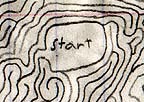
What is an original idea? My philosophy is that nothing comes from the void (except for maybe the Big Bang...). Today’s inventions are the product of those that have come before. So what does it take to come up with a unique idea? It’s the natural result of curiosity and a desire to solve a problem. Often an invention is simultaneously discovered in different parts of the world. Well, Superplexus has influences too. (Continued...)
1979 – Equilibre Hable
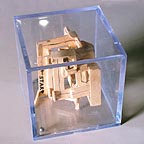
When I was a junior in high school, my family relocated from Illinois to California. We lived in Petaluma for one year while my parents looked for property on which to build a house. While at Casa Grande High School, I took an art class from Ed Hairston. He gave us an art project which was to design a board game. Well, I really didn't like board games since I lost almost every time I played. So instead, I decided to make a 3D maze. (Continued...)
1980 – Mass Production?
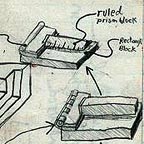
My first attempt at getting the game mass produced was when I was a freshman at Santa Rosa Junior College. John Watrous was teaching sculpture there. He had a big influence on me as an artist. His classes were the best I've ever taken -up to, and including, graduate school. We have become life-long friends. He may not remember this, but John encouraged me to contact toy manufacturers. After going to Plover Library and researching American toy and game companies in the Thomas Register, I used his office telephone to call Hasbro (toll free, mind you) and they wouldn't even hear my idea. (Continued...)
1987 – Over The Edge!
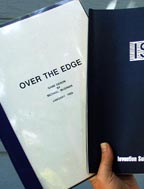
Fresh out of Graduate School from the University of Kansas, I began teaching Figure Sculpture at Santa Rosa Junior College. It was time to think about the game again. The name, “Equilibre Hable”, was terrible from the beginning. People were being driven crazy by the difficulty of the first model. “Psychopath” came to mind again, but its negative connotations nixed the idea. “Over The Edge!” made sense because, like psychopath, it had a double meaning. (Continued...)
1997 – Meeting KID

Ten years had passed since beginning my teaching career. It was clear to me that I needed to seriously pursue the toy, or some day it would be too late. By this time I was much better at designing, and spent a number of years on my own learning to build furniture. I was teaching a digital art class at the Petaluma Campus of SRJC in the spring of 1997. In that class was Erin Montague. She was the only person I ever asked “Do you know anyone in the toy industry?”. (Continued...)
1999 – Perplexus

Here is a classic tale of success and failure. In September of 1999, KID made a connection with Stewart Sims, who just started a new toy company called “NeXT ELECTRONIX,” a division of Playmates Toys. Years before, Stewart was responsible for bringing Rubik's Cube to the western world. He felt that my game could be a real success, and wanted to create a whole new line from it. His goal was to have a working game ready by the American International Toy Fair in New York City, a mere five months away. (Continued...)
August 2000 – Superplexus I
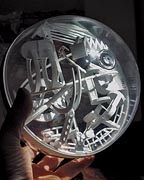
After the NeXT debacle, I began work on a bigger model. I remember it well, because after working on so many small designs, this big one contained much more activity! I made gantries, pivots, scoops, tightropes, and even a magnetic section that required the ball to be rolled upside down. This model, which I called “Superplexus I”, was far too complicated to manufacture. KID loved it as much as I did.
November 2000 – Superplexus II
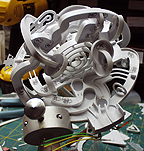
KID asked me to design a manufacturable model of “Superplexus”. They wanted to show it to Hasbro. That meant using intersecting elements (or planes) which contained little or no undercuts. “Superplexus II” (reference name, only) needed visual complexity, interesting challenges, a limited number of parts, and simple methods of interconnection. We laid out a basic plan of attack, that it utilized some of the successful elements of both “Perplexus” and “Superplexus I”.
2002 – Worldwide Release!
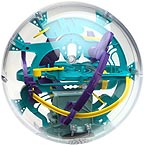
The most gratifying feelings of accomplishment came from finding random images of people and their Superplexii around the world, and in reading about how much they enjoyed it. I received emails from as far away as the Netherlands. Superplexus was requested by little English girls in a letter to Santa published through the BBC. It was becoming popular in Japan and Germany too. At one point it was rated in the “Top Ten Christmas Gifts” in the UK.
2007 – Giant Superplexus
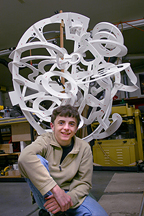
Ten years have passed since Erin Montague got my foot in the door. Fulfilling a lifelong dream is no easy task. I have planned on making very large versions of Superplexus since the late 1970s. Building a model of my first Giant Superplexus is just the beginning of this new journey. My goal is to interest science museums, malls, airports, corporations, cities, and the like, into letting me build huge Superplexii in spheres, floating on a cushion of air.
2008 – Superplexus Vortex
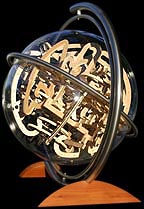
The first opportunity to build a museum-quality Giant Superplexus appeared in the form of a phone call from George Miller, who was curating an exhibit for the Sonoma Valley Museum of Art. The exhibit, entitled, “Intersections: Puzzles As Art” was to open on June 20th of 2009. George commissioned me to design and build a unique piece for the show. We worked out a list of requirements and deadlines, made a contract while eating Mexican food, and with a check for materials, I proceeded to my shop.
2009 – Perplexus (Buksi & PlaSmart)
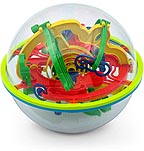
One day, while searching eBay for Superplexus, I came across a picture of an item listed as Superplexus... but it wasn’t! Instead, it was a UFO-shaped squished version using elements of the original, but with lots of parts missing. The UFO Explorer was brightly colored but very cheap looking. I ordered one. Yes, it was a knock-off from China. Then I found a literal duplicate of Superplexus called “Magicel Intenect Ball”, and bought that one. It was a bit disconcerting. But then a really good thing happened.